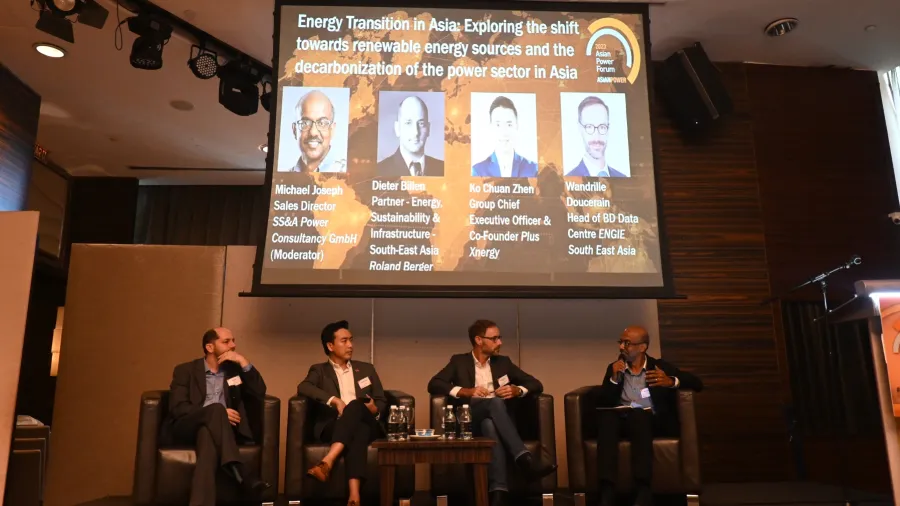
Asian Power Forum 2023 focuses on Malaysia’s energy transition
Industry experts converge in Kuala Lumpur to discuss consumer confidence, RE initiatives, and the future of green hydrogen.
Transitioning to cleaner and sustainable energy took centre stage at the Asian Power Forum 2023 held recently at Impiana KLCC Hotel in Kuala Lumpur. Energy industry experts and leaders gathered to discuss the drivers and opportunities for Malaysia’s energy transition.
One key aspect explored during the forum was Malaysia’s direction in boosting the deployment of renewable energy (RE). The leaders delved into strategies and initiatives aimed at increasing the country’s reliance on clean energy sources and the critical role of consumers.
Understanding consumers
In the realm of energy transition, Mark Bennett, the Asia-Pacific Energy CX Transformation leader at Ernst & Young, aptly described energy consumers as standing at a pivotal “crossroads of confidence.”
To bear this confidence toward energy transition, consumers must have their beliefs anchored on the stability of energy providers, their value, access to clean energy, affordability, and equity. In this regard, consumer confidence is low in some countries like Japan, Ireland, and Belgium.
Bennett observed a contrasting perspective in Asia, where consumers perceive their energy transition trajectory as steadfastly aligned with progress. Notably, China is the first among nations that see the energy transition in their markets going in the right direction, followed by Malaysia and Hong Kong.
“We need to keep them confident in the energy transition. Remember, consumers are paying for this. They are spending money with their confidence and need to maintain confidence,” Bennett said.
He noted that Malaysia’s energy consumers are becoming increasingly engaged and active participants in the energy ecosystem, shedding their passivity. So, within the market, the majority of consumers can be classified into distinct categories.
The largest group, comprising 32% of the population, is the “novices” who exhibit indifference towards energy matters. Following them are the “allies” who represent the cost-conscious consumers. The “enthusiasts” or those who are service-centric and aware of energy alternatives comprise 16% of the total, whilst the “bystanders” or energy-reliant and the “champions” or active about ecoenergy alternatives each account for 11%.
To illustrate how reducing energy costs remain a priority in the past year, the willingness to pay more for sustainable products and services increased to 57% in 2022 from 46% in 2021.
“The consumer is changing fundamentally,” Bennett said. “We need to… save the planet, time and money, [and] give [consumers] more control.”
Still, there are factors that prevent some consumers from making that choice, such as affordability, benefits, accessibility, and complexity.
Green energy initiatives
To boost the adoption of renewable energy, Plus Xnergy Group CEO and Co-founder, Ko Chuan Zhen, highlighted the Corporate Green Power Programme (CGPP) in Malaysia. The CGPP aims to incentivise corporations to install year-round operational solar photovoltaic (PV) systems.
Ko noted several benefits from participating in the CGPP, among them the long-term ownership of the Renewable Energy Certificate, the fulfilment of environment, social, and governance requirements, and saving money on carbon tax payments, amongst others.
This comes as the company aims to reach a 70% renewables capacity target by 2050 which means the country has to more than double its projects as clean energy currently accounts for 20% of its generation capacity.
“Malaysia is the closest it has been to the energy transition and businesses hold the key. There are now more external and internal valuable opportunities for businesses to access carbon neutrality,” he said.
RE deployment and uptake
The Lantau Group’s senior advisor, Fazal Othman Mohd Ghazali, cited Malaysia’s journey to ramping up the deployment and uptake of RE. This journey encompasses significant milestones, from the implementation of The Environment Facility Small Grants Programme in 2000, followed by the Malaysia Renewable Energy Roadmap and Green Electricity Tariff in 2021, and culminating in the National Energy Policy in 2022.
Ghazali said another part of the country’s energy transition efforts is exploring a cross-border purchase initiative. A pilot study is currently underway to import hydropower from Laos to Malaysia, with Thailand serving as an intermediary.
However, there are challenges to overcome, such as the cost of constructing a dedicated interconnector in Thailand and the need for effective government-to-government cooperation. These obstacles must be addressed to successfully implement this cross-border energy project.
One other challenge facing the CGPP implementation is the restriction that solar power producers can only submit one application limited to 30 megawatts. The cost may be a deterrent as the power purchase agreement would be in addition to the regular electricity tariff.
However, there are positive developments such as the lifting of Malaysia’s renewable energy export ban and the establishment of cross-border wheeling charges, among other policies.
Looking ahead, it is crucial for Malaysia to focus on crafting sensible policies and providing support for power and green credit trading, Ghazali said.
Decarbonising various sectors
The Asian Power Forum was also graced by Wandrille Doucerain, head of BD Data Centre Solutions at ENGIE South East Asia, who tackled the dedicated assets to decarbonise data centres in the country.
Noting that Malaysia is a “hot market” for data centres, Doucerain highlighted the significance of the sector’s decarbonising efforts to further enhance the country’s energy transition and facilitate a sustainable and greener future.
His insights also illuminated the panel discussion with Ko of Plus Xnergy Group; Dieter Billen, partner on Energy, Sustainability & Infrastructure for South-East Asia at Roland Berger; and Michael Joseph, sales director at SS&A Power Consultancy GmbH, when their discussion veered towards decarbonisation of the power sector in Asia.
Billen noted that there are a lot of companies that are taking an interest in adopting renewables whilst existing energy companies are set on exploring other new solutions such as hydrogen.
Ko mentioned some of the barriers in the energy transition such as utility infrastructure. He cited concerns over grid stability in Southeast Asia, amongst others. Doucerain also shared his insights on the energy transition drivers in the region.
Tapping into green hydrogen
At one point, Billen presented green hydrogen as a promising sector for the energy transition.
His strategic management consultancy firm anticipates the emergence of 119 gigawatts (GW) of mature green hydrogen projects by 2030, with Europe taking the lead at 44GW, largely driven by robust policy measures. In the Asia Pacific region, there are projected to be 33GW of green hydrogen projects, with China considered a “closed market” and Australia focusing on export-oriented initiatives.
This, he said, showcases the potential for green hydrogen to play a significant role in shaping the energy landscape of the future.
Despite the anticipated growth in mature green hydrogen projects by 2030, the projected figures fall short of the substantial commitments made by governments, which amount to approximately 230 GW. Also, there are around 450 GW of announced projects and an additional 720 GW identified by the International Energy Agency (IEA) as necessary to meet climate targets by 2030.
At present, only about 0.5 GW of green hydrogen projects are operational, highlighting the significant gap that needs to be bridged to achieve the required scale of development in this sector.
In Southeast Asia, Billen said green hydrogen is a nascent market due to difficulties to get projects to start such as finding off-takers and financing.
“There is no real market at this point and no strong incentives in most countries in the region,” he said, adding that markets in the region should start with a smaller scale focused on domestic demand or local operation.
Billen said power producers should focus on the production side as a logical starting point for green hydrogen. To facilitate rapid growth and adoption, it is crucial to ensure nearby demand, particularly in the industrial and heavy-duty mobility sectors.
“Demand for green [hydrogen] in Southeast Asia will take off more rapidly once [the] government provides incentives or imposes high carbon taxes,” he said.



















 Advertise
Advertise






